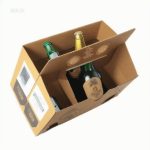
In the world of power tools, first impressions matter more than you might think. While the focus naturally falls on the quality and performance of drills, saws, and sanders, there’s an unsung hero that plays a crucial role in the user experience: the power tools packaging box. These aren’t just ordinary containers; they’re sophisticated protective systems designed to safeguard your investment while telling a compelling brand story. From reinforced cardboard constructions to custom foam inserts, today’s power tool packaging represents a perfect marriage of form and function that begins working long before you ever plug in your new tool.
The evolution of power tools packaging has been remarkable. Gone are the days of flimsy cardboard that barely survived the shipping process. Modern packaging engineers have developed multi-layered protection systems that can withstand drops, compression, and environmental hazards. High-density foam cradles precisely contoured to each tool component prevent movement during transit, while water-resistant coatings protect against moisture damage. These advancements mean that when you receive your power tool, it arrives in the same pristine condition it left the factory – ready to perform without any hidden damage from shipping stresses.
Beyond protection, power tools packaging serves as a critical branding opportunity. The unboxing experience has become a moment of theater that can strengthen customer loyalty and generate social media buzz. Companies investing in premium packaging with clean graphics, clear product information, and thoughtful organization find that customers perceive their tools as higher quality – even before using them. The psychological impact of well-designed packaging shouldn’t be underestimated; it sets expectations for the precision and care that went into the tool itself.
Sustainability has become a driving force in packaging innovation, and the power tools industry is rising to the challenge. Many manufacturers now use recycled materials for their boxes and are designing packaging that can be repurposed as storage solutions. Some innovative companies have introduced packaging that transforms into tool organizers or project cases, extending the lifecycle of the materials while providing added value to customers. This eco-conscious approach not only reduces environmental impact but also resonates with today’s environmentally aware consumers.
The functionality of power tools packaging extends well beyond the initial unboxing. Well-designed packaging often incorporates features that make storage and transportation more convenient. Molded handles, stackable designs, and integrated compartments for accessories transform packaging into practical storage solutions. For professionals who need to transport tools to job sites, the original packaging frequently becomes part of their organizational system, protecting tools between uses and ensuring all accessories remain together.
From a retail perspective, power tools packaging plays a vital role in theft prevention and inventory management. Security features like tamper-evident seals and anti-theft hanging mechanisms help protect valuable merchandise. Meanwhile, barcodes, QR codes, and clear product identification streamline the checkout process and inventory tracking. The packaging must also comply with various international standards and regulations, including safety warnings and certification markings that inform consumers about proper usage.
Looking toward the future, smart packaging technologies are beginning to emerge in the power tools sector. Some premium packages now include NFC chips or QR codes that link to tutorial videos, digital manuals, or registration portals. This digital integration enhances the user experience while providing manufacturers with valuable customer insights. As technology advances, we may see packaging that incorporates sensors to monitor for tampering or environmental conditions during shipping, providing an additional layer of quality assurance.
The development of effective power tools packaging requires extensive testing and engineering. Packages undergo rigorous evaluation including vibration testing, drop testing, compression testing, and climate simulation. This scientific approach ensures that packaging can protect tools through the entire supply chain – from manufacturing facilities to retail shelves to customers’ workshops. The investment in proper testing pays dividends in reduced returns and damaged goods, ultimately benefiting both manufacturers and consumers.
In conclusion, power tools packaging represents a critical intersection of protection, branding, and sustainability. These carefully engineered containers do much more than simply hold products – they enhance perceived value, improve user experience, and protect significant investments. As consumers become more discerning and environmental concerns grow, packaging innovation will continue to be a competitive differentiator in the power tools market. The humble packaging box has truly become an essential component of the power tool ecosystem, proving that sometimes the box is just as important as what’s inside.




Leave a Message